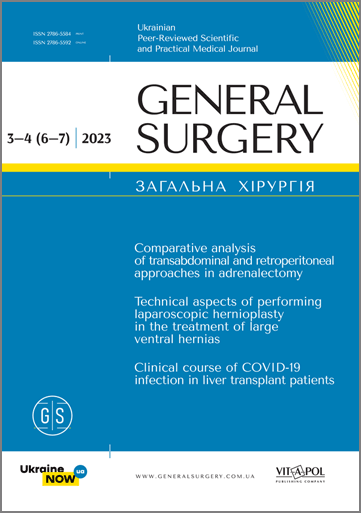Treatment tactics for gastric erosive-ulcerative bleeding on the background of liver cirrhosis
DOI:
https://doi.org/10.30978/GS-2023-3-46Keywords:
endoscopic hemostasis, hemorrhage, liver cirrhosis, stomach ulcerAbstract
Analysing the polymorphism of etiological factors that contribute to the development of erosive‑ulcerative gastric lesions in patients with liver cirrhosis (acid‑peptic factors, transformation of venous blood flow, immune complexes, etc.), it should be noted that portal hypertension is the most important cause of these lesions. Bleeding from erosive‑ulcerative gastric lesions is a direct cause of death, occupying the first place in the structure of mortality and far exceeding ulcer perforations in this regard. Mortality in the first massive acute gastric bleeding reaches 50%, after the second — 70%, in hepatic coma — 80% or more.
Objective — to improve the treatment outcomes for patients with erosive and ulcerative bleeding in the stomach due to liver cirrhosis.
Materials and methods. The treatment outcomes of 192 patients with the hepatic form of portal hypertension (liver cirrhosis) who were hospitalised in the therapeutic and surgical departments, which are the clinical bases of the Department of Surgery No. 2 at Bogomolets National Medical University, were studied for the period from 2005 to 2023. During upper endoscopy, degenerative changes in the gastric mucosa were detected in 94 (48.9%) patients. Specifically, gastric erosions were observed in 31 (33.0%) patients, gastric ulcers in 34 (36.2%), and portal gastropathy in 29 (30.8%) patients. A total of 88 (46.6%) patients with liver cirrhosis and acute gastric bleeding were admitted to the surgical department as an emergency. According to the Child‑Pugh scale, the vast majority of patients were at the stage of sub‑ and decompensation (71 patients, or 89.1%). In 41 (45.2%) patients, gastric cancer was attributed to gastric erosive and ulcerative lesions: erosive gastritis — in 20 (48.8%) patients and gastric ulcer — in 21 (51.2%) patients.
Results. Enhancing the protective properties of the mucous‑bicarbonate barrier of the gastric mucosa as part of pathogenetic conservative treatment schemes can reduce the influence of this mechanism on the development of hemorrhagic complications in 89.4% of patients. The risk of bleeding in this group of patients with liver cirrhosis is 15.1%, which requires the search for new methods of conservative treatment. In 79.6% of cases, primary endoscopic hemostasis of bleeding erosive‑ulcerative gastric lesions was effective when combined with drug therapy. For 53.1% of patients, it proved to be the final treatment. This enabled a reduction in overall mortality to 22.4% from 50% (p <0.05) and, if necessary, a delay in surgical intervention. Out of the total number of patients, 19 (38.8%) patients required surgical intervention, with 73.7% of them undergoing urgent surgery and 26.3% undergoing delayed surgery. When considering operative methods for peptic ulcers complicated by hemorrhage, preference should be given to organ‑ and function‑preserving interventions. They yield more favourable immediate outcomes for this extremely challenging group of patients (postoperative mortality was reduced to 26.3% vs. 50.0% (p <0.05).
Conclusions. Acute gastric bleeding resulting from erosive‑ulcerative gastric lesions, which are complications of liver cirrhosis, can significantly impair the health of patients. However, by implementing modern treatment technologies, such as surgical procedures, it is feasible to achieve a 50% reduction in both overall and postoperative mortality.
References
Ardevol A, Ibañez-Sanz G, Profitos J, et al. Survival of patients with cirrhosis and acute peptic ulcer bleeding compared with variceal bleeding using current first-line therapies. Hepatology. 2018 Apr;67(4):1458-71. Epub 2018 Feb 18. PMID: 28714072.
Bang CS, Baik GH, Kim JH, et al. Peptic ulcer disease in liver cirrhosis and chronic hepatitis: impact of portal hypertension. Scand J Gastroenterol. 2014 Sep;49(9):1051-7. http://doi.org/10.3109/00365521.2014.923501. Epub 2014 Jun 5. PMID: 24902119.
Khan AU, Mandiga P. Gastrointestinal Bleeding Scan. 2023 Aug 14. In: StatPearls [Internet]. Treasure Island (FL): StatPearls Publishing; 2023 Jan–. PMID: 31335037.
Kolosovych IV, Hanol IV, Uzun H. Role of erosive and ulcerative gastric lesions in the development of hemorrhagic complications in liver cirrhosis. Fiziol Zh. 2022; 68(5): 44-50. https://doi.org/10.15407/fz68.05.044.
Korotkiy VM, Kolosovych IV, Pekus OM, Bystrov EB, Chertischev SS. Gastroduodenal ulcer: issues of oncogenesis and pathogenetic principles of surgical treatment. Surgery of Ukraine. 2004; 1:30-3. Ukrainian.
Laine L, Jensen DM. Management of patients with ulcer bleeding. Am J Gastroenterol. 2012 Mar;107(3):345-60; quiz 361. http://doi.org/10.1038/ajg.2011.480. Epub 2012 Feb 7. PMID: 22310222.
Mullady DK, Wang AY, Waschke KA. AGA Clinical Practice Update on endoscopic therapies for non-variceal upper gastrointestinal bleeding: expert review. Gastroenterology. 2020 Sep;159(3):1120-8. http://doi.org/10.1053/j.gastro.2020.05.095. Epub 2020 Jun 20. PMID: 32574620.
Noh JH, Cha B, Ahn JY, et al. Scoring systems for predicting clinical outcomes in peptic ulcer bleeding. Medicine (Baltimore). 2022 Sep 9;101(36):e30410. http://doi.org/10.1097/MD.0000000000030410. PMID: 36086775.
Tandon P, Bishay K, Fisher S, Yelle D, Carrigan I, Wooller K, Kelly E. Comparison of clinical outcomes between variceal and non-variceal gastrointestinal bleeding in patients with cirrhosis. J Gastroenterol Hepatol. 2018 Oct;33(10):1773-9. http://doi.org/10.1111/jgh.14147. Epub 2018 May 4. PMID: 29601652.
Tokar JL, Higa JT. Acute Gastrointestinal Bleeding. Ann Intern Med. 2022 Feb;175(2):ITC17-ITC32. http://doi.org/10.7326/AITC202202150. Epub 2022 Feb 8. PMID: 35130044.].
Tuerk E, Doss S, Polsley K. Peptic Ulcer Disease. Prim Care. 2023 Sep;50(3):351-62. http://doi.org/10.1016/j.pop.2023.03.003. Epub 2023 May 24. PMID: 37516507.
Wilkins T, Wheeler B, Carpenter M. Upper gastrointestinal bleeding in adults: evaluation and management. Am Fam Physician. 2020 Mar 1;101(5):294-300. Erratum in: Am Fam Physician. 2021 Jan 15;103(2):70. PMID: 32109037.
Downloads
Published
How to Cite
Issue
Section
License
Copyright (c) 2024 Authors

This work is licensed under a Creative Commons Attribution-NoDerivatives 4.0 International License.






